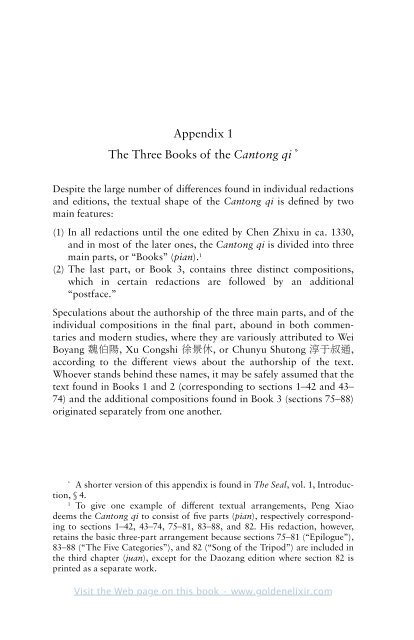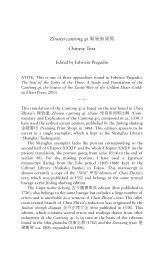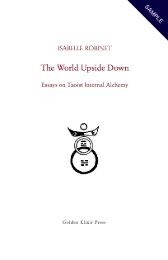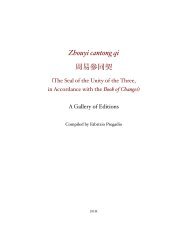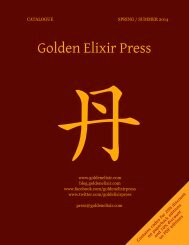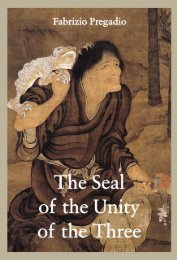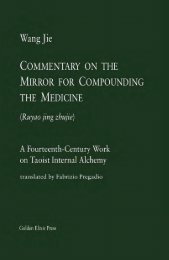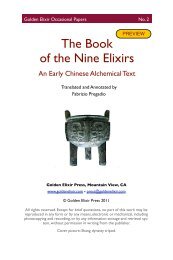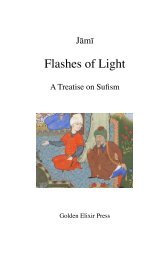The Seal of the Unity of the Three â Vol. 2 - The Golden Elixir
The Seal of the Unity of the Three â Vol. 2 - The Golden Elixir
The Seal of the Unity of the Three â Vol. 2 - The Golden Elixir
- No tags were found...
You also want an ePaper? Increase the reach of your titles
YUMPU automatically turns print PDFs into web optimized ePapers that Google loves.
Appendix 1<br />
<strong>The</strong> <strong>Three</strong> Books <strong>of</strong> <strong>the</strong> Cantong qi *<br />
Despite <strong>the</strong> large number <strong>of</strong> differences found in individual redactions<br />
and editions, <strong>the</strong> textual shape <strong>of</strong> <strong>the</strong> Cantong qi is defined by two<br />
main features:<br />
(1) In all redactions until <strong>the</strong> one edited by Chen Zhixu in ca. 1330,<br />
and in most <strong>of</strong> <strong>the</strong> later ones, <strong>the</strong> Cantong qi is divided into three<br />
main parts, or “Books” (pian). 1<br />
(2) <strong>The</strong> last part, or Book 3, contains three distinct compositions,<br />
which in certain redactions are followed by an additional<br />
“postface.”<br />
Speculations about <strong>the</strong> authorship <strong>of</strong> <strong>the</strong> three main parts, and <strong>of</strong> <strong>the</strong><br />
individual compositions in <strong>the</strong> final part, abound in both commentaries<br />
and modern studies, where <strong>the</strong>y are variously attributed to Wei<br />
Boyang 魏 伯 陽 , Xu Congshi 徐 景 休 , or Chunyu Shutong 淳 于 叔 通 ,<br />
according to <strong>the</strong> different views about <strong>the</strong> authorship <strong>of</strong> <strong>the</strong> text.<br />
Whoever stands behind <strong>the</strong>se names, it may be safely assumed that <strong>the</strong><br />
text found in Books 1 and 2 (corresponding to sections 1–42 and 43–<br />
74) and <strong>the</strong> additional compositions found in Book 3 (sections 75–88)<br />
originated separately from one ano<strong>the</strong>r.<br />
*<br />
A shorter version <strong>of</strong> this appendix is found in <strong>The</strong> <strong>Seal</strong>, vol. 1, Introduction,<br />
§ 4.<br />
1<br />
To give one example <strong>of</strong> different textual arrangements, Peng Xiao<br />
deems <strong>the</strong> Cantong qi to consist <strong>of</strong> five parts (pian), respectively corresponding<br />
to sections 1–42, 43–74, 75–81, 83–88, and 82. His redaction, however,<br />
retains <strong>the</strong> basic three-part arrangement because sections 75–81 (“Epilogue”),<br />
83–88 (“<strong>The</strong> Five Categories”), and 82 (“Song <strong>of</strong> <strong>the</strong> Tripod”) are included in<br />
<strong>the</strong> third chapter (juan), except for <strong>the</strong> Daozang edition where section 82 is<br />
printed as a separate work.<br />
Visit <strong>the</strong> Web page on this book • www.goldenelixir.com


